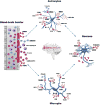Neuroinflammatory targets and treatments for epilepsy validated in experimental models
- PMID: 28675563
- PMCID: PMC5873599
- DOI: 10.1111/epi.13783
Neuroinflammatory targets and treatments for epilepsy validated in experimental models
Abstract
A large body of evidence that has accumulated over the past decade strongly supports the role of inflammation in the pathophysiology of human epilepsy. Specific inflammatory molecules and pathways have been identified that influence various pathologic outcomes in different experimental models of epilepsy. Most importantly, the same inflammatory pathways have also been found in surgically resected brain tissue from patients with treatment-resistant epilepsy. New antiseizure therapies may be derived from these novel potential targets. An essential and crucial question is whether targeting these molecules and pathways may result in anti-ictogenesis, antiepileptogenesis, and/or disease-modification effects. Therefore, preclinical testing in models mimicking relevant aspects of epileptogenesis is needed to guide integrated experimental and clinical trial designs. We discuss the most recent preclinical proof-of-concept studies validating a number of therapeutic approaches against inflammatory mechanisms in animal models that could represent novel avenues for drug development in epilepsy. Finally, we suggest future directions to accelerate preclinical to clinical translation of these recent discoveries.
Keywords: Anti-ictogenesis; Antiepileptogenesis; Disease modification; Drug development; Epilepsy; Immune response; Inflammation.
Wiley Periodicals, Inc. © 2017 International League Against Epilepsy.
Conflict of interest statement
The authors declare that they have no conflict of interest to disclose. We confirm that we have read the Journal’s position on issues involved in ethical publication and affirm that this report is consistent with those guidelines.
Figures

References
-
- Aronica E, Crino PB. Inflammation in epilepsy: clinical observations. Epilepsia. 2011;52(Suppl 3):26–32. - PubMed
-
- Aronica E, Ravizza T, Zurolo E, et al. Astrocyte immune responses in epilepsy. Glia. 2012;60:1258–1268. - PubMed
-
- Vezzani A, Aronica E, Mazarati A, et al. Epilepsy and brain inflammation. Exp Neurol. 2013;244:11–21. - PubMed
Publication types
MeSH terms
Substances
Grants and funding
LinkOut - more resources
Full Text Sources
Other Literature Sources
Medical
Miscellaneous

